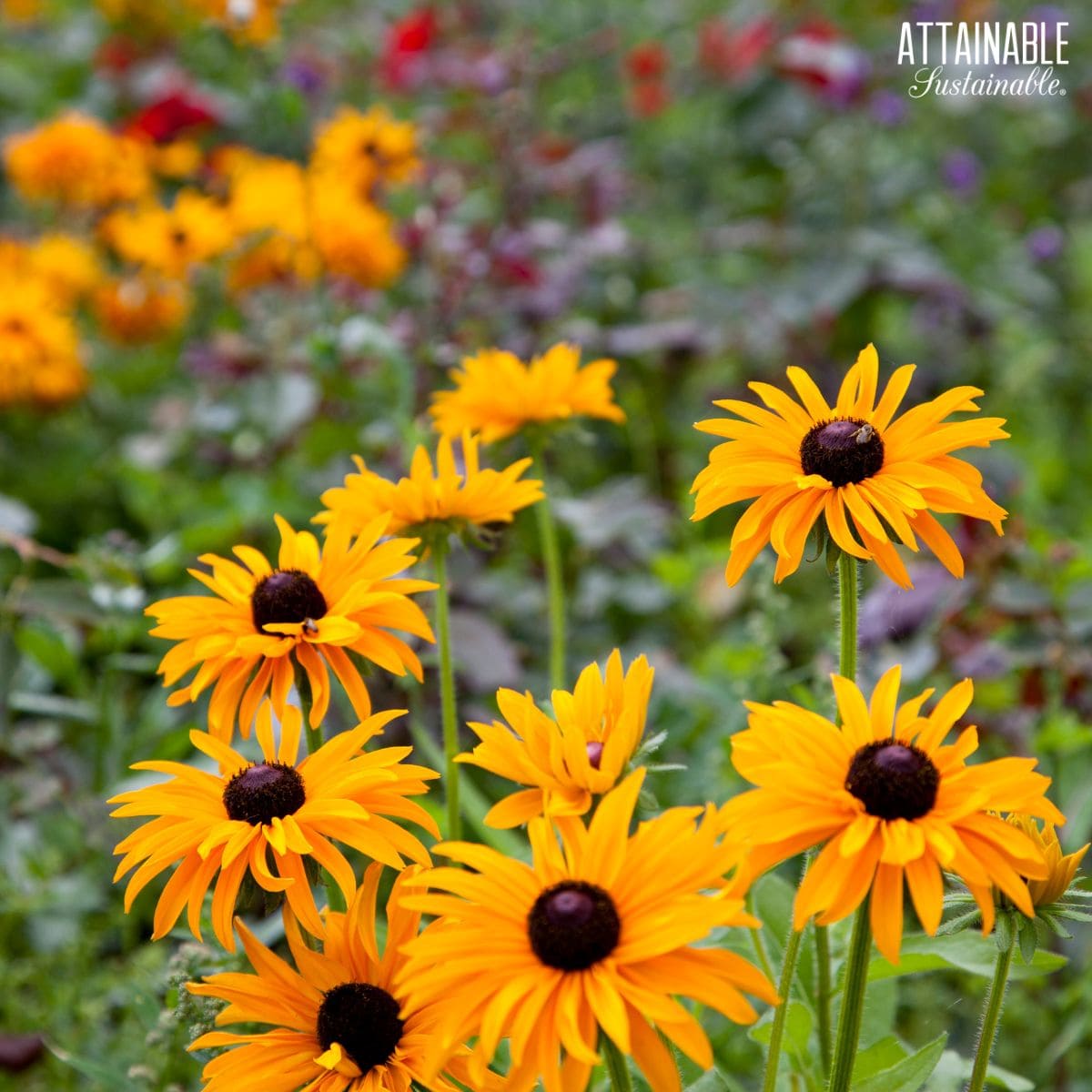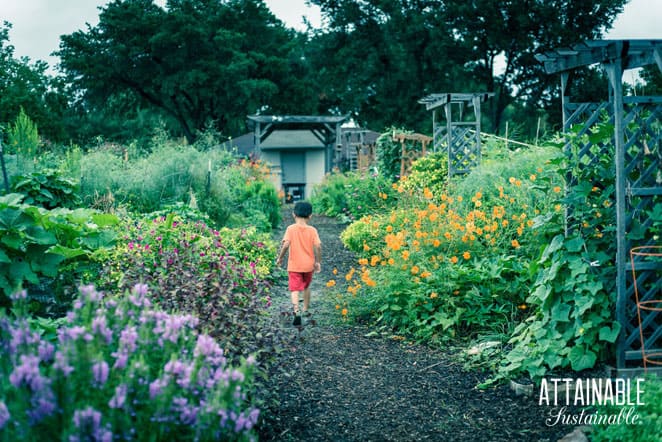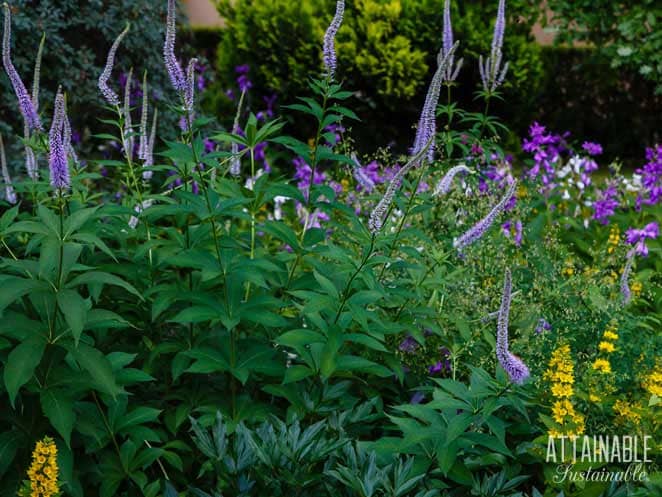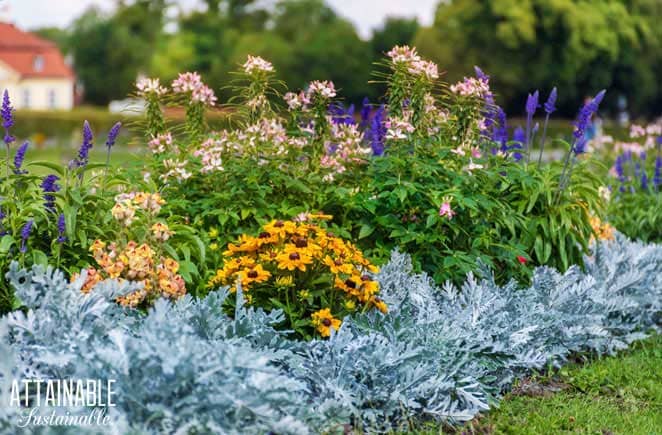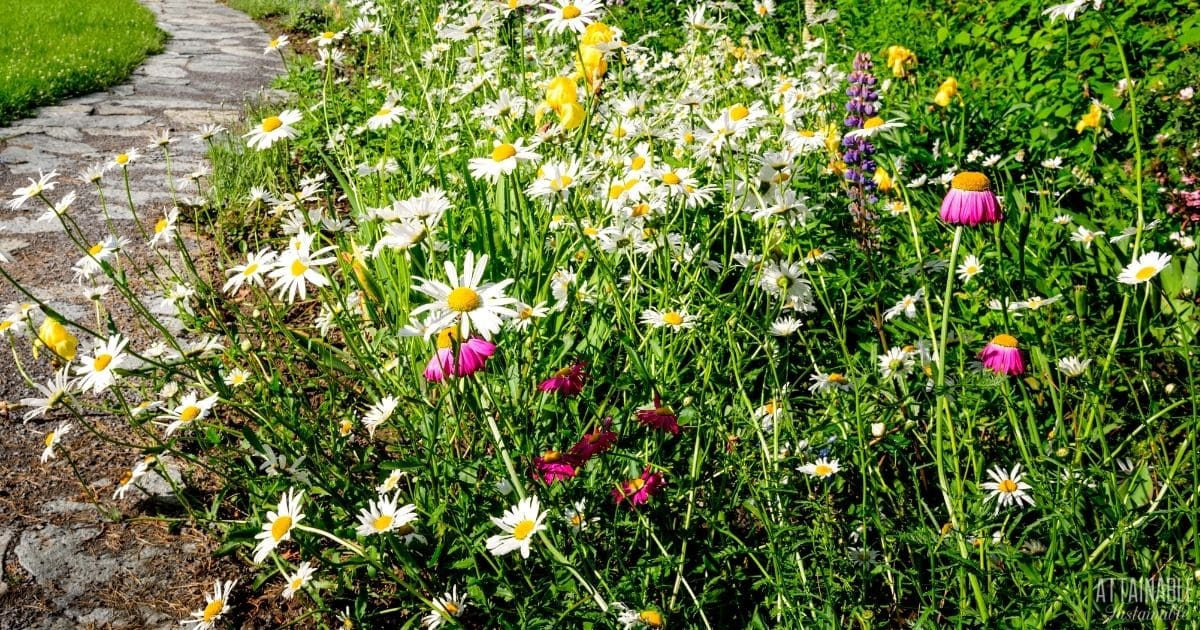Eco-friendly landscaping is a boon to the environment, but can also save you time and money in the long run! Embrace these ideas to create a beautiful and thriving ecosystem right in your backyard.
Looking for some plants prettier enough for the front yard? Check out these edible but pretty plants!

Eco-Friendly Landscaping
If you’re ready to turn your yard into a non-toxic oasis for both you and the critters who live nearby, these tactics will give you some ideas on where to get started!
Step 1: Reduce or Eliminate the Traditional Lawn
When we start thinking about eco-friendly landscape ideas, we really have to start with lawns. The modern lawn is far from sustainable. To create an eco-friendly yard, you’ll have to think beyond the traditional lawn. With some knowledge and creativity, your yard can become a biodiverse, sustainable haven.
This step can be difficult to wrap your mind around at first. After all, a lush, green lawn is almost a status symbol. In fact, vast expanses of groomed grass were made popular by George Washington and Thomas Jefferson in the 18th century; there’s nothing people like so much as emulating the wealthy. Today, lawns are commonplace. And they are incredibly impractical to maintain.
Grow Some Greens!
Ready to grow fresh greens, no matter WHERE you live? Sign up for my
FREE quick-start guide and start growing some of your own food!
The Environmental Downside of a Lawn
For the vast majority of people, keeping up with a yard full of grass requires a lot of time as well as environmentally unfriendly measures:
- Lots of water. The typical irrigation system wastes a lot of one of the most precious resources on the planet: water. Even with conservation efforts, the amount of water it takes to keep a lawn healthy and green in an arid climate is just too much. It makes much more sense to plant what thrives in your climate than to constantly be in a battle with nature itself.
- Toxic lawn chemicals. The perfectly shorn, weed-free lawn is simply not what nature designed. Aside from water, most grassy lawns require regular use of fertilizers, pesticides, fungicides, and herbicides just to maintain the grass. This is a hazard to local wildlife and can downright poison groundwater and waterways with toxic runoff.
- Carbon emissions. Because lawns need to be cut and edged so often, the carbon emissions caused by lawn equipment is a serious concern. Even if you have electric equipment, most of us aren’t hooked up to a sustainable source of electricity, which means mowing the lawn still results in emissions even with an electric mower.
So if an eco-friendly landscape is a priority, considering ditching the grassy lawn altogether. There are much better options available!
Step 2: Create Permanent Installations
Areas like patios, pathways, and walkways are often called hardscapes. These are installations that are permanent and when designing an eco-friendly landscape, a good way to reduce weed growth with little to no maintenance. Consider the areas you use and the paths you travel in your yard frequently; think about using pavers, gravel, or wood chips to eliminate or reduce turf area.
Step 3: Focus on Biodiversity and Native Plants
Think about it: habitats in nature contain a lot of diversity. A huge variety of trees, shrubs, grasses, and other plants create an ecosystem that sustains many species like insects, birds, small mammals, and more.
Both plants and animals thrive in an environment with a lot of diversity. We need to step away from the monoculture of modern lawns and start creating biodiverse yards.
A truly eco-friendly yard should try to mimic this idea of a natural ecosystem as much as possible. Think of it as building plant communities. Fill your yard with a variety of plants like native trees, shrubs, ornamental grasses, flowering plants that bloom during different seasons, and herbs.
Why Choose Native Plants in an Eco-Friendly Landscape
An important step to creating a yard that functions like an ecosystem to is choosing plants native to your local climate and soil conditions. This naturally reduces the need for excess water or chemical additives like fertilizer because the plants will already be in the perfect environment they need to thrive.
By choosing native plants, you’re encouraging biodiversity in so many ways. You’re creating a sanctuary for local, lesser-known species to propagate and thrive, rather than planting what’s popular on a national level (which encourages everyone everywhere to plant the same small selection of species).
You’re also giving native birds, beneficial insects, and other wildlife the perfect plants for food and shelter. It’s a great way to encourage pollinators to hang around!
To find out more about which plants are native in your region, seek out the Master Gardeners at your local Cooperative Extension Office or plug your location into this native plant finder.
Step 4: Reduce Water Usage
Conserving water is another important way to create an eco-friendly yard. Water shortages are a very real issue in many regions, but water is a precious resource everywhere. Conserving water is a must for living sustainably.
Here are a few simple ways you can reduce water usage for an eco-friendly yard:
- Plant native, drought-tolerant plants. Once established, drought-tolerant landscaping will need the least amount of water and be relatively maintenance free.
- Use organic mulch as a ground cover. Mulch reduces the need to water while also naturally preventing weeds.
- Opt for a drip irrigation system or soaker hoses rather than sprinklers. Drip systems are designed to provide customized, slow-and-steady water flow to specific plants. Sprinklers throw a lot of water everywhere at once, which causes a lot of water waste and uneven watering.
- Consider rainwater collection and other ways to “reuse” water to conserve water usage in the yard. Install a rain barrel, collect grey water for supplemental watering, and be sure to monitor soil moisture so you’re only watering when necessary.
Step 5: Eliminate the Use of Toxic Chemicals
Getting rid of your grassy lawn is an important first step to reducing the need for toxic chemicals like fertilizers and pesticides. But even with eco-friendly plants, there can be some temptation to use commercial chemicals to help them thrive. Here are some tips for eliminating those toxic options:
- Again, choosing native plants can make a significant impact in this area. Because they’re growing in their natural environment, native plants don’t need strong chemical fertilizers to grow and thrive.
- The same goes for biodiversity. A biodiverse yard will encourage the presence of birds, insects, and mammals that will naturally control pest populations.
- Use mulch and compost to protect soil, prevent weeds, and provide nutrients for plants.
- Use environmentally-friendly pest control when absolutely needed, such as diatomaceous earth and neem oil.

